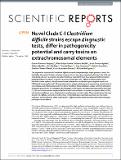Mostrar el registro sencillo del ítem
Novel Clade C-I Clostridium difficile strains escape diagnostic tests, differ in pathogenicity potential and carry toxins on extrachromosomal elements
| dc.creator | Ramírez Vargas, Gabriel | |
| dc.creator | López Ureña, Diana | |
| dc.creator | Badilla Lobo, Adriana | |
| dc.creator | Orozco Aguilar, Josué | |
| dc.creator | Murillo Corrales, Tatiana | |
| dc.creator | Rojas, Priscilla | |
| dc.creator | Riedel, Thomas | |
| dc.creator | Overmann, Jörg | |
| dc.creator | González, Gabriel | |
| dc.creator | Chaves Olarte, Esteban | |
| dc.creator | Quesada Gómez, Carlos | |
| dc.creator | Rodríguez Sánchez, César | |
| dc.date.accessioned | 2018-11-02T16:11:34Z | |
| dc.date.available | 2018-11-02T16:11:34Z | |
| dc.date.issued | 2018 | |
| dc.identifier.citation | https://www.nature.com/articles/s41598-018-32390-6 | |
| dc.identifier.issn | 2045-2322 | |
| dc.identifier.uri | https://hdl.handle.net/10669/76045 | |
| dc.description.abstract | The population structure of Clostridium difficile currently comprises eight major genomic clades. For the highly divergent C-I clade, only two toxigenic strains have been reported, which lack the tcdA and tcdC genes and carry a complete locus for the binary toxin (CDT) next to an atypical TcdB monotoxin pathogenicity locus (PaLoc). As part of a routine surveillance of C. difficile in stool samples from diarrheic human patients, we discovered three isolates that consistently gave negative results in a PCR-based screening for tcdC. Through phenotypic assays, whole-genome sequencing, experiments in cell cultures, and infection biomodels we show that these three isolates (i) escape common laboratory diagnostic procedures, (ii) represent new ribotypes, PFGE-types, and sequence types within the Clade C-I, (iii) carry chromosomal or plasmidal TcdBs that induce classical or variant cytopathic effects (CPE), and (iv) cause different levels of cytotoxicity and hamster mortality rates. These results show that new strains of C. difficile can be detected by more refined techniques and raise questions on the origin, evolution, and distribution of the toxin loci of C. difficile and the mechanisms by which this emerging pathogen causes disease. | es_ES |
| dc.description.sponsorship | Federal State of Lower Saxony/[(VWZN2889/3215/3266]/FSLS/Alemania | es_ES |
| dc.description.sponsorship | German Center for Infection Research/[BMBF grant 8000-105-3]/DZIF/Alemania | es_ES |
| dc.description.sponsorship | Universidad de Costa Rica/UCR/Costa Rica | es_ES |
| dc.language.iso | en_US | es_ES |
| dc.relation.ispartof | ||
| dc.source | Scientific Reports; Volumen 8, Número 13951. 2018 | es_ES |
| dc.title | Novel Clade C-I Clostridium difficile strains escape diagnostic tests, differ in pathogenicity potential and carry toxins on extrachromosomal elements | es_ES |
| dc.type | artículo original | |
| dc.date.updated | 2018-10-26T00:46:02Z | |
| dc.identifier.doi | 10.1038/s41598-018-32390-6 | |
| dc.description.procedence | UCR::Vicerrectoría de Investigación::Unidades de Investigación::Ciencias de la Salud::Centro de Investigación en Enfermedades Tropicales (CIET) | es_ES |
| dc.description.procedence | UCR::Vicerrectoría de Investigación::Unidades de Investigación::Ciencias de la Salud::Laboratorio de Ensayos Biológicos (LEBI) | es_ES |
Ficheros en el ítem
Este ítem aparece en la(s) siguiente(s) colección(ones)
-
Microbiología [1171]


